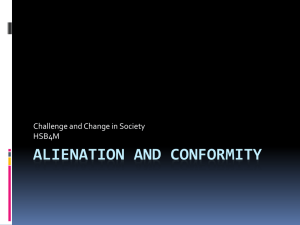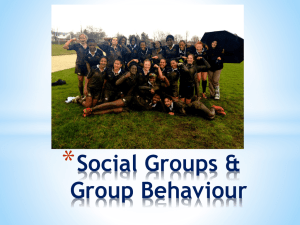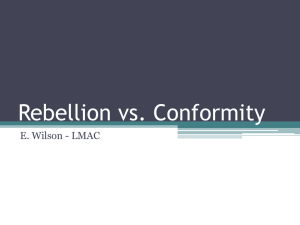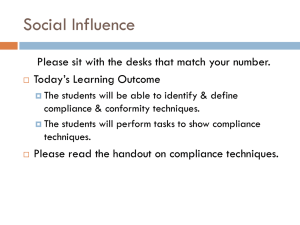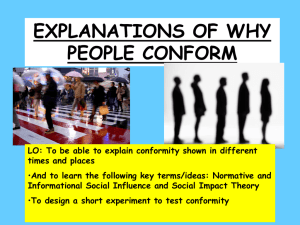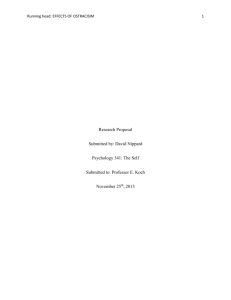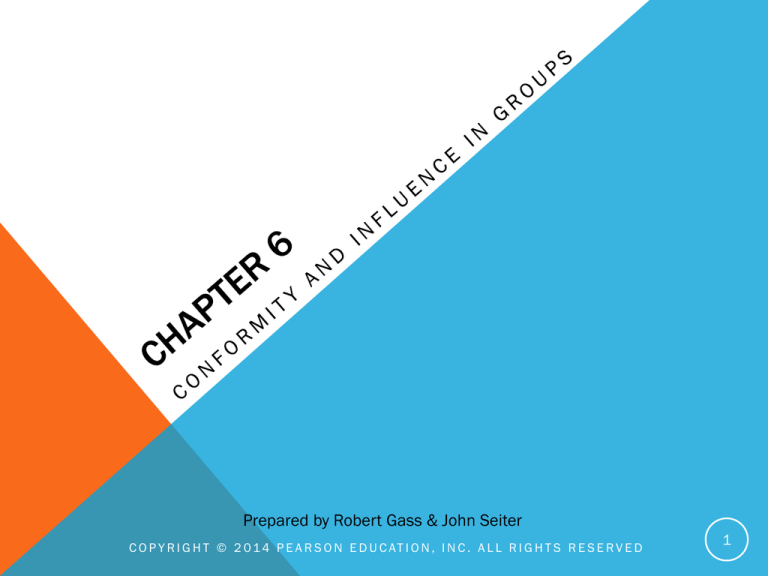
Prepared by Robert Gass & John Seiter
C O P Y R I G H T © 2 01 4 P E A R S O N E D U C AT I O N , I N C . A L L R I G H T S R E S E R V E D
1
CONFORMITY TO GROUP NORMS
Norms are expectations governing group member’s behavior
Norms may be explicit or formal
not cheating on a test
not texting while driving
Norms may be implicit, informal
not picking your nose during class
Not taking your clothes off in class
Norms may not be apparent until they are violated
Is it okay to wake someone up to ask her/him a favor?
Is it okay to ask your ex-girlfriend’s sister out?
2
C O P Y R I G H T © 2 01 4 P E A R S O N E D U C AT I O N , I N C . A L L R I G H T S R E S E R V E D
EARLY CONFORMITY RESEARCH
Asch found conformity to group judgments was common
Individuals estimated the length of lines
Group members (confederates) offered different judgments
75% of all subjects modified their estimates at least once to
conform to the group
25% remained largely independent of the group’s judgment
Public conformity doesn’t necessarily imply private
conformity
C O P Y R I G H T © 2 01 4 P E A R S O N E D U C AT I O N , I N C . A L L R I G H T S R E S E R V E D
3
INFLUENCE OF NORMS
Groups may punish deviation from established
norms
Norms are most influential in ambiguous social
situations
Subjects littered more in a setting where others
were seen littering
Norms may persist even if they are dysfunctional
“Win at any cost” mentality in business
“Codes of silence” among police officers
C O P Y R I G H T © 2 01 4 P E A R S O N E D U C AT I O N , I N C . A L L R I G H T S R E S E R V E D
4
GROUP SIZE AND CONFORMITY
Social impact theory (SIT)
Social influence model (SIM)
The first few person added
to a group exerts the most
pressure to conform
The 3rd and 4th members
added exert the most
pressure to conform
Each additional member
adds pressure to conform,
but their influence is
proportionally less
With a 3rd or 4th member,
coalitions can emerge
For example, the 5th group
member has more
influence than the 9th
group member
C O P Y R I G H T © 2 01 4 P E A R S O N E D U C AT I O N , I N C . A L L R I G H T S R E S E R V E D
5
GROUP SIZE AND CONFORMITY
Informational influence
Consistent with social influence model
Emphasis is on the group being correct
More heads are likely to know the answer than one
1st person added has the greatest impact (later members’ opinions
become redundant)
More important when responding in private
Normative influence
Members want to be liked, accepted by the group
Fitting in matters more than being right
Consistent with social impact theory
More important when responding in a group
C O P Y R I G H T © 2 01 4 P E A R S O N E D U C AT I O N , I N C . A L L R I G H T S R E S E R V E D
6
RESISTING PRESSURE TO CONFORM
Morality as motivated resistance hypothesis
People with stronger moral convictions are better at
resisting pressure to conform
It is difficult for a lone dissenter to resist unanimous
group pressure
A holdout with even one ally can resist more easily
A second dissenter decreases conformity by 80%
C O P Y R I G H T © 2 01 4 P E A R S O N E D U C AT I O N , I N C . A L L R I G H T S R E S E R V E D
7
INDOCTRINATION & INITIATION
Initiation rituals may entail hazing, humiliation, or even
violence
Fraternity/sorority initiations
Hazing new firefighter recruits
Gang initiations
Marines’ “blood pinning” ceremony
Members tend to value groups more when initiations
are intense
Consistent with the “effort-justification” paradigm in
cognitive dissonance
C O P Y R I G H T © 2 01 4 P E A R S O N E D U C AT I O N , I N C . A L L R I G H T S R E S E R V E D
8
CULT INDOCTRINATION
Cult indoctrination often follows four stages:
1 softening up stage
Befriending, self-affirmation, “love bombing”
2 compliance stage
Milieu control over sleep, diet, appearance
3 internalization stage
New members incorporate cult doctrine
4 consolidation stage
Loyalty tests, donations, recruitment
C O P Y R I G H T © 2 01 4 P E A R S O N E D U C AT I O N , I N C . . A L L R I G H T S R E S E R V E D
9
FACTORS AFFECTING CONFORMITY
Identification and reference groups
Reference groups provide standards of
comparison for self-appraisal
“Keeping up with the Joneses…”
People consider reference groups when
making decisions
What professor to take
What smartphone to buy
C O P Y R I G H T © 2 01 4 P E A R S O N E D U C AT I O N , I N C . A L L R I G H T S R E S E R V E D
10
FACTORS AFFECTING CONFORMITY
Ethnocentrism
Belief in the superiority of
one’s own culture
One’s own culture is the
standard by which other
cultures should be judged
Strong culture
Extreme loyalty and
identification with one’s
organization
Groupthink
Members engage in
consensus-seeking
They reinforce one another’s
opinions
They fail to question or analyze
ideas
C O P Y R I G H T © 2 01 4 P E A R S O N E D U C AT I O N , I N C . A L L R I G H T S R E S E R V E D
11
GENDER AND CONFORMITY
In general women tend to conform more than men
Sex roles affect conformity
Females are socialized to be more communal
Males are socialized to be more independent
Status also affects conformity; a female CEO may conform
less than a male middle manager
C O P Y R I G H T © 2 01 4 P E A R S O N E D U C AT I O N , I N C . A L L R I G H T S R E S E R V E D
12
PEER PRESSURE AND CONFORMITY
Peer influence increases during adolescence
Peer pressure can promote risky behaviors
tobacco, alcohol, drug use
Peer pressure can lead to aggression
Hazing, teasing, ostracism can spark violence
Online hazing can trigger suicides
Peer pressure also has positive effects
Peers also model desirable behaviors
Peer pressure cut smoking rates in half (Rosenberg, 2011)
C O P Y R I G H T © 2 01 4 P E A R S O N E D U C AT I O N , I N C . A L L R I G H T S R E S E R V E D
13
PERSONALITY AND CONFORMITY
Managers with high cognitive complexity conform less in
stressful situations than those with low cognitive
complexity
People who are high on control conform less than those
who are low on control
High self-monitors tend to conform more than low selfmonitors
People with a high need for affiliation conform more than
those who don’t desire to belong so much
Dogmatic people tend to conform more than nondogmatics, but only for highly respected sources
C O P Y R I G H T © 2 01 4 P E A R S O N E D U C AT I O N , I N C . A L L R I G H T S R E S E R V E D
14
CULTURE AND CONFORMITY
Power-Distance
People from high power-distance
cultures tend to value obedience,
authority
People from low power-distance
cultures tend to value individual
autonomy
Tolerance for ambiguity
Some cultures have a higher
tolerance for ambiguity than others
Masculine-Feminine
People from “masculine” cultures
tend to conform less than people
from “feminine” cultures
Individualism-Collectivism
Individualistic cultures view
conformity more negatively
Collectivistic cultures view
conformity more positively
Less tolerance for ambiguity tends
to produce more conformity
C O P Y R I G H T © 2 0 1 4 P E A R S O N E D U C AT I O N , I N C . A L L R I G H T S R E S E R V E D
15
THE WHY’S OF CONFORMITY
Group locomotion hypothesis
The individual goes along to
achieve the goals of the group
Social comparison theory
The group is a yardstick for
measuring one’s own
performance
Consistency theory
Epistemological weighting
hypothesis
Members think the group
knows more than they do
Hedonistic hypothesis
Members conform to receive
social benefits, avoid social
punishment
Liking and identification with the
group discourages deviance
C O P Y R I G H T © 2 01 4 P E A R S O N E D U C AT I O N , I N C . A L L R I G H T S R E S E R V E D
16
SOCIAL PROOF
Monkey see, monkey do
People base their behavior on
what others are doing
Internet piracy
Urban graffiti
Viral marketing relies on social
proof
A social phenomenon is
spread by word of mouth
Groupon and word of mouth
Sales and social proof
Consumer ratings and reviews
Yelp, Urbanspoon, TripAdvisor
Prosocial behavior
reusable shopping bags
volunteerism
Negative social proof
Cheating
bullying
C O P Y R I G H T © 2 01 4 P E A R S O N E D U C AT I O N , I N C . A L L R I G H T S R E S E R V E D
17
OSTRACISM
Social ostracism involves excluding or ignoring others
Shunning as a practice in some religious communities
Campus shootings are often attributable to social ostracism
Cyber-bullying
Social ostracism makes some people long for attention,
recognition
Social ostracism makes some people more vulnerable to
influence attempts
C O P Y R I G H T © 2 01 4 P E A R S O N E D U C AT I O N , I N C . A L L R I G H T S R E S E R V E D
18
DEINDIVIDUATION
Depersonalization
Individual identity is subsumed to that
of the group
A diffusion of responsibility occurs
Anonymity increases deindividuation
Negative social consequences
Lynch mobs
Vandalism by unruly sports fans
Treatment of detainees at Abu Ghraib
prison in Iraq
Crowd size affects antisocial behavior
Bystander effects
Bystanders may fail to help in
an emergency
Self-Awareness
Increasing private selfawareness reduces
deindividuation
Increasing accountability
decreases deindividuation
C O P Y R I G H T © 2 01 4 P E A R S O N E D U C AT I O N , I N C . A L L R I G H T S R E S E R V E D
19
THE BYSTANDER EFFECT
Richmond, CA, 2009: A 15 year
Increasing private awareness can
old was gang raped outside her high overcome the bystander effect
school’s homecoming dance
The ordeal lasted 2 ½ hours
Identifying individuals can overcome
the bystander effect
At least 20 passers-by failed to
call police
“You, in the red sweater, call 911!”
Other witnesses watched,
laughed, and took pictures
“Ma’am, I need your help. Go pull
the fire alarm”
Steubenville, Ohio, 2013: an
unconscious 16 year old girl was
sexually assaulted by two high
school football players
Fellow students shared pictures
about the event via social media
C O P Y R I G H T © 2 01 4 P E A R S O N E D U C AT I O N , I N C . A L L R I G H T S R E S E R V E D
20
DEINDIVIDUATION & SOCIAL LOAFING
Slackers: People exert less effort in
a group than working alone
The Ringlemann effect: in a tug of
war, adding team members reduces
individual effort
Decision making & problem solving:
as members are added, individual
effort tapers off
Collective effort model
Free ride effect
Members coast if they are
anonymous
Members coast if they aren’t
personally accountable
Sucker effect
Productive members slack off
when they see others aren’t
working
Members coast when individuals’
contributions can’t be distinguished
C O P Y R I G H T © 2 01 4 P E A R S O N E D U C AT I O N , I N C . A L L R I G H T S R E S E R V E D
21
REDUCING SOCIAL LOAFING
The larger the group, the less likely people are to help
Limiting group size can reduce social loafing
Assessing individual performance reduces social loafing
Diligent isolates are less likely to engage in social loafing,
but may foster social loafing in others
Social facilitation
Groups may motivate people to try harder
Energizing effect of groups can lead to greater risk-taking
C O P Y R I G H T © 2 01 4 P E A R S O N E D U C AT I O N , I N C . A L L R I G H T S R E S E R V E D
22
RISK-TAKING BEHAVIOR
Risky-shift phenomenon
Groups are tend to make riskier
decisions than individuals
The group’s consensus is typically
riskier than the average risk-level of
its members
Group polarization
Groups enhance members’ preexisting tendencies toward risktaking or risk-aversion
High risk-takers skew the average
willingness of the group to assume
risks
Social comparison theory
Members entertain ideas they
would not otherwise consider
Persuasive arguments theory (PAT)
The most vocal members advocate
the most extreme views
There can also be a shift toward
greater caution
More vocal members may
advocate greater caution
C O P Y R I G H T © 2 01 4 P E A R S O N E D U C AT I O N , I N C . A L L R I G H T S R E S E R V E D
23




